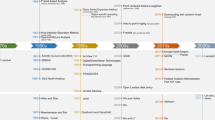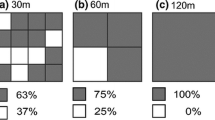Abstract
Context
Reliable scaling relationships allow prediction of unknown quantities at scales not directly observed. Scaling relationships for landscape patterns are commonly estimated following a process of coarse graining, in which pixels are aggregated and a mathematical function is then fit across the multiple resolutions. However, few studies have investigated how aggregation changes the landscape composition and configuration, which in turn alters the fitted scaling function and any predictions made using that function.
Objective
Evaluate how changes in composition/configuration produced by coarse graining affect scaling function fit and the accuracy of that function for predicting patterns at finer resolutions than observed.
Methods
Neutral model landscapes with controlled composition/configuration were generated in QRule. Each raster was aggregated to seven coarser resolutions, and landscape metrics computed. Five scaling functions were fit to the seven-value set for each landscape and metric. The best-performing function for each landscape/metric was downscaled to predict the metric at a fine resolution not used in the scale-fitting process. Downscaling accuracy was measured through relative error.
Results
(1) The power law is the only function that consistently fit scalograms across all compositions/configurations. (2) Downscaling accuracy is more sensitive to configuration than composition. (3) Majority rules aggregation preserves information better with dispersed land covers. (4) Downscaling accuracies were highest around power law exponents of − 0.5 suggesting the structure of the power law may affect results.
Conclusions
Aggregation impacts the fit and use of scaling functions for downscaling/prediction. Research to differentiate aggregation effects from physical processes in complex, real-world landscapes is needed.







Similar content being viewed by others
Data Availability
The data that support the findings of this study are available in Figshare with the identifier(s) at the link https://doi.org/10.6084/m9.figshare.11413395.v1 (https://figshare.com/s/4ce7913e57a9739cd26a).
Code availability
The codes that support the findings of this study are available in Figshare with the identifier(s) at the link https://doi.org/10.6084/m9.figshare.11413395.v1 (https://figshare.com/s/4ce7913e57a9739cd26a).
References
Argañaraz JP, Entraigas I (2014) Scaling functions evaluation for estimation of landscape metrics at higher resolutions. Eco Inform 22:1–12
Bailey TC, Gatrell AC (1995) Interactive spatial data analysis. Longman Scientific & Technical Essex
Benson BJ, MacKenzie MD (1995) Effects of sensor spatial resolution on landscape structure parameters. Landsc Ecol 10:113–120
Bettencourt LM, Lobo J, Helbing D, Kühnert C, West GB (2007) Growth, innovation, scaling, and the pace of life in cities. Proc Natl Acad Sci 104:7301–7306
Bierkens M, Finke P, De Willigen P (2000) Upscaling and downscaling methods for environmental research. Kluwer Academic, Dordrecht
Brown JH, Gupta VK, Li B-L, Milne BT, Restrepo C, West GB (2002) The fractal nature of nature: power laws, ecological complexity and biodiversity. Philos Trans R Soc Lond Ser B 357:619–626
Bull WB (1975) Allometric change of landforms. Geol Soc Am Bull 86:1489–1498
Church M, Mark DM (1980) On size and scale in geomorphology. Prog Phys Geogr 4:342–390
Fotheringham AS, Wong DW (1991) The modifiable areal unit problem in multivariate statistical analysis. Environ Plan A 23:1025–1044
Frazier AE (2014) A new data aggregation technique to improve landscape metric downscaling. Landsc Ecol 29:1261–1276
Frazier AE (2015) Landscape heterogeneity and scale considerations for super-resolution mapping. Int J Remote Sens 36:2395–2408
Frazier AE (2016) Surface metrics: scaling relationships and downscaling behavior. Landsc Ecol 31:351–363
Gardner RH, Urban DL (2007) Neutral models for testing landscape hypotheses. Landsc Ecol 22:15–29
Gardner RH, Milne BT, Turnei MG, O’Neill RV (1987) Neutral models for the analysis of broad-scale landscape pattern. Landsc Ecol 1:19–28
Gardner RH, O’Neill RV (1991) Pattern, process, and predictability: the use of neutral models for landscape analysis. Ecol Stud 82:289–307
Gehlke CE, Biehl K (1934) Certain effects of grouping upon the size of the correlation coefficient in census tract material. J Am Stat Assoc 29:169–170
Hesselbarth MH, Sciaini M, With KA, Wiegand K, Nowosad J (2019) landscapemetrics: an open-source R tool to calculate landscape metrics. Ecography 42(10):1648–1657
Holt D, Steel D, Tranmer M, Wrigley N (1996) Aggregation and ecological effects in geographically based data. Geogr Anal 28:244–261
Jelinski DE, Wu J (1996) The modifiable areal unit problem and implications for landscape ecology. Landsc Ecol 11:129–140
Jiang B (2015) The fractal nature of maps and mapping. Int J Geogr Inf Sci 29:159–174
Kedron PJ, Frazier AE, Ovando-Montejo GA, Wang J (2018) Surface metrics for landscape ecology: a comparison of landscape models across ecoregions and scales. Landsc Ecol 33:1489–1504
Levin SA (1992) The problem of pattern and scale in ecology: the Robert H MacArthur Award Lecture. Ecology 73:1943–1967
Li H, Reynolds JF (1993) A new contagion index to quantify spatial patterns of landscapes. Landsc Ecol 8:155–162
Ma Q, Wu J, He C, Hu G (2018) Spatial scaling of urban impervious surfaces across evolving landscapes: from cities to urban regions. Landsc Urban Plan 175:50–61
McGarigal K, Cushman SA, Ene E (2012) FRAGSTATS v4: Spatial Pattern Analysis Program for Categorical and Continuous Maps. Computer Software Program produced by the authors at the University of Massachusetts, Amherst. http://www.umass.edu/landeco/research/fragstats/fragstats.html
Neel MC, McGarigal K, Cushman SA (2004) Behavior of class-level landscape metrics across gradients of class aggregation and area. Landsc Ecol 19:435–455
Newman EA, Kennedy MC, Falk DA, McKenzie D (2019) Scaling and complexity in landscape ecology. Front Ecol Evol 7:293
O’Neill RV, Krummel JR, Gardner RH, Sugihara BJG, DeAngelis DL, Milne BT, Turner MG, Zygmunt B, Christensen SW, Dale VH, Graham RL (1988) Indices of landscape pattern. Landsc Ecol 1:10
Openshaw S (1977) A geographical solution to scale and aggregation problems in region-building, partitioning and spatial modelling. Trans Inst Br Geogr 459–472
Openshaw S (1984) Ecological fallacies and the analysis of areal census data. Environ Plan A 16:17–31
Openshaw S, Taylor PJ (1979) A million or so correlation coefficients: three experiments on the modifiable areal unit problem. Stat Appl Spatial Sci 21:127–144
Raj R, Hamm NA, Kant Y (2013) Analysing the effect of different aggregation approaches on remotely sensed data. Int J Remote Sens 34:4900–4916
Riitters KH (2005) Downscaling indicators of forest habitat structure from national assessments. Ecol Ind 5:273–279
Saupe D (1988) Algorithms for random fractals. In: The science of fractal images. Springer, pp 71–136
Saura S, Castro S (2007) Scaling functions for landscape pattern metrics derived from remotely sensed data: Are their subpixel estimates really accurate? ISPRS J Photogramm Remote Sens 62:201–216
Schneider DC (1998) Applied scaling theory. In: Ecological scale: theory and applications, pp 253–270
Schneider DC (2001a) The Rise of the Concept of Scale in Ecology the concept of scale is evolving from verbal expression to quantitative expression. Bioscience 51:545–553
Schneider DC (2001b) Spatial allometry: theory and application to experimental and natural aquatic ecosystems. In: Gardner RH (ed) Scaling relations in experimental ecology. Columbia University Press, New York, pp 113–153
Tate N, Atkinson PM (2001) Modelling scale in geographical information science. Wiley, New York
Tischendorf L, Bender DJ, Fahrig L (2003) Evaluation of patch isolation metrics in mosaic landscapes for specialist vs. generalist dispersers. Landsc Ecol 18:41–50
Turner MG (1989) Landscape ecology: the effect of pattern on process. Annu Rev Ecol Syst 20:171–197
Turner MG, O’Neill RV, Gardner RH, Milne BT (1989) Effects of changing spatial scale on the analysis of landscape pattern. Landsc Ecol 3:153–162
Turner MG, Gardner RH, O’Neill RV (2001) Landscape ecology in theory and practice. Springer, New York
West GB (2017) Scale: the universal laws of growth, innovation, sustainability, and the pace of life in organisms, cities, economies, and companies. Penguin, New York
With KA, King AW (1997) The use and misuse of neutral landscape models in ecology. Oikos 219–229
With KA, King AW (1999) Dispersal success on fractal landscapes: a consequence of lacunarity thresholds. Landsc Ecol 14:73–82
Woldenberg MJ (1969) Spatial order in fluvial systems: Horton’s laws derived from mixed hexagonal hierarchies of drainage basin areas. Geol Soc Am Bull 80:97–112
Wong D (2009) The modifiable areal unit problem (MAUP). The SAGE handbook of spatial analysis, pp 105–123
Wu J (2004) Effects of changing scale on landscape pattern analysis: scaling relations. Landsc Ecol 19:125–138
Wu J (2007) Scale and scaling: a cross-disciplinary perspective. In: Wu J, Hobbs R (eds) Key topics in landscape ecology. Cambridge University Press, Cambridge, pp 115–142
Wu J, Li H (2006a) Concepts of scale and scaling. In: Scaling and uncertainty analysis in ecology. Springer, pp 3–15
Wu J, Li H (2006b) Perspectives and methods of scaling. In: Scaling and uncertainty analysis in ecology. Springer, pp 17–44
Xu C, Zhao S, Liu S (2020) Spatial scaling of multiple landscape features in the conterminous United States. Landsc Ecol 35:223–247
Zhang N, Li H (2013) Sensitivity and effectiveness and of landscape metric scalograms in determining the characteristic scale of a hierarchically structured landscape. Landsc Ecol 28:343–363
Funding
This research was funded by a Grant to A. Frazier and P. Kedron from the National Science Foundation (#SBE-1561021).
Author information
Authors and Affiliations
Contributions
Conceptualization: AF and PK; methodology: AF and PK; data collection and curation, GO and YZ; software:, AF, PK, GO and YZ; formal analysis: AF, PK, GO and YZ; writing—original draft preparation: AF and PK; writing—review and editing: AF, PK, GO and YZ; visualizations: AF and PK; project administration: AF and PK.
Corresponding author
Ethics declarations
Consent for publication
Yes.
Additional information
Publisher's Note
Springer Nature remains neutral with regard to jurisdictional claims in published maps and institutional affiliations.
Supplementary Information
Below is the link to the electronic supplementary material.
Rights and permissions
About this article
Cite this article
Frazier, A.E., Kedron, P., Ovando-Montejo, G.A. et al. Scaling spatial pattern metrics: impacts of composition and configuration on downscaling accuracy. Landsc Ecol 38, 689–704 (2023). https://doi.org/10.1007/s10980-021-01349-w
Received:
Accepted:
Published:
Issue Date:
DOI: https://doi.org/10.1007/s10980-021-01349-w




